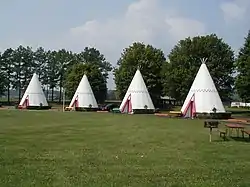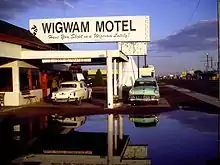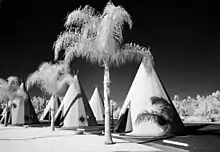Wigwam Village #6 | |
 Wigwam Motel | |
  | |
| Location | 811 W. Hopi Dr., Holbrook, Arizona 86025[1] |
|---|---|
| Coordinates | 34°54′8.05″N 110°10′5.76″W / 34.9022361°N 110.1682667°W |
| Built | 1950 |
| Architect | Frank Redford, Chester Evert Lewis |
| MPS | Historic US Route 66 in Arizona MPS |
| NRHP reference No. | 02000419[2] |
| Added to NRHP | May 2, 2002 |
The Wigwam Motels, also known as the "Wigwam Villages," is a motel chain in the United States built during the 1930s and 1940s. The rooms are built in the form of tipis, mistakenly referred to as wigwams.[3] It originally had seven different locations: two locations in Kentucky and one each in Alabama, Florida, Arizona, Louisiana, and California.
They are very distinctive historic landmarks. Two of the three surviving motels are located on historic U.S. Route 66: in Holbrook, Arizona, and in San Bernardino, California. All three of the surviving motels are listed on the National Register of Historic Places: the Wigwam Motel in Cave City, Kentucky, was listed in 1988 under the official designation of Wigwam Village #2; the Wigwam Motel in Arizona was listed as Wigwam Village #6 in 2002; and the Wigwam Motel in California was listed in 2012 as Wigwam Village #7.
History
Frank A. Redford developed the Village after adding tipi-shaped motel units around a museum-shop he had built to house his collection of Native American artifacts.[3] He applied for a patent on the ornamental design of the buildings on December 17, 1935, and was granted Design Patent 98,617 on February 18, 1936. The original drawing includes the swastika, at the time a symbol associated with Native Americans or often worn as a good-luck charm.
Seven Wigwam Villages were built between 1933 and 1949.
Wigwam villages
Village #1: Horse Cave, Kentucky

The first Wigwam Village was built in 1933 by Frank A. Redford. It was located on the corner of US-31E and Hwy 218 in Horse Cave, Kentucky.
The central building and gas pumps are visible on undated postcards. Six more wigwams were built to be used as guest rooms.
Village #1 closed in 1935 when the nearby Wigwam Village #2 was opened, but operated under different names until it was eventually abandoned; it was razed in 1982.[4][5]
Village #2: Cave City, Kentucky

Wigwam Village #2 was built in 1937 on U.S. Route 31W[6] in Cave City, Kentucky, close to Mammoth Cave National Park and a few miles south of the original Wigwam Village #1. The address is 601 North Dixie Hwy, Cave City, Kentucky. ( 37°08'43.0"N, 85°56'43.8"W )
It consists of 15 wigwams used as guest rooms that are arranged in a semicircle. In the center is a much bigger concrete and steel central structure that originally served as a restaurant, plus a common area with playground, recreation space, and pavilion.[7] Each wigwam has a paved pad to accommodate one car.[7] The restaurant is no longer in operation, but the motel is still open.[7][8]
The diameter at the base of each tipi is 14 feet (4.3 m), and they are 32 feet (9.8 m) in height. Behind the main room of each unit is a small bathroom with sink, toilet, and shower. In 2008, the rooms contain the original restored hickory furniture and a window-mounted air conditioner. There are no telephones to maintain the original atmosphere of the motel, but the rooms do have cable TV and internet access.

Wigwam Village #2 is listed in the National Register of Historic Places.[2] It achieved this status on March 16, 1988.[6]
Village #3: New Orleans, Louisiana
This wigwam village was built in 1940, on U.S. Route 61 in Metairie, a suburb of New Orleans, Louisiana. It included a restaurant, cocktail bar, souvenir shop, and Esso service station.[10] Village #3 went out of business in 1954, leaving little documentation behind.[11]
Village #4: Orlando, Florida
Wigwam Village #4 was built in 1948, and was located at 700 S. Orange Blossom Trail. The builder, Jerry Kinsley, later served as mayor of Edgewood, Florida.[12][13]
This relatively large wigwam village consisted of 27 guest rooms, each in a separate wigwam constructed to resemble a horseshoe shape, with four additional wigwams, likely housing offices and a restaurant.[14] A pool was located in the middle of the lot. Village #4 claimed to be "Orlando's largest and finest Motel."[10]
Village #4 was razed in 1974, and replaced with a Days Inn.[13] The only part of the original design that survived was the swimming pool.[15] An attempt to save some of the tipis by using a helicopter to airlift them to a YMCA Summer Camp failed, as they were too heavy to move.[14][15] A 330-room Vacation Lodge now sits on the site.[14]
Village #5: Bessemer, Alabama
The Wigwam Village #5 was built in 1940 in Bessemer, Alabama. It was located 4 miles (6.4 km) north of downtown Bessemer, on U.S. Route 11,[4] and included 15 guest cabins, arranged in a semicircle around the restaurant, restrooms, and offices.[4][11] Rather than the steel, lath, and plaster of Redford's original design, the Village #5 structures were made of steel, wood, and felt, then covered in canvas and treated with linseed oil.[11]
Village #5 went out of business in 1964, and was demolished after falling into ruin, although the restaurant reportedly stood until 1970.[4][10]
Village #6: Holbrook, Arizona

Arizona motel owner Chester E. Lewis built this Wigwam Village in 1950. It is located on the historic Route 66,[16] at 811 West Hopi Drive in Holbrook, Arizona.[17] Nearby places of interest include Petrified Forest National Park, Meteor Crater (Barringer Crater), and the Grand Canyon.[3]
The plans for this motel were based on the original of Frank A. Redford. Lewis first became aware of the distinctive wigwam designs when passing through Cave City in 1938. He purchased the rights to Redford's design, as well as the right to use the name "Wigwam Village," in a novel royalty agreement: coin-operated radios would be installed in Lewis's Wigwam Village, and every dime inserted for 30 minutes of play would be sent to Redford as payment.[18]

The motel is arranged as a square, with 15 concrete and steel wigwams on three sides and the main office on the fourth, flanked by two smaller sized wigwams; there was also originally a gas station on the complex.[3] The individual units are called "wigwams," not "rooms" or "tepees" or "cabins." The units are numbered from 1 to 16, (there is no 13). The base diameter is 14 feet (4.3 m), with each unit 32 feet (9.8 m) in height. Behind the main room of each unit is a small bathroom with sink, toilet and shower. Current rooms contain the original restored hickory furniture, two double beds, satellite TV and a window-mounted air conditioner. In keeping with the authenticity of the restoration, there are no telephones or ice machine. Vintage restored automobiles from the 1960s and earlier are located throughout the parking area. Small green metal benches etched with the words "Wigwam Village #6" are scattered throughout the complex as well.
Lewis operated the motel until closing it in 1974 when Interstate 40 bypassed downtown Holbrook. Two years after his death in 1986, sons Clifton and Paul Lewis and daughter Elinor renovated the motel before reopening it in 1988.[18]
The Lewis family continues to run and maintain Wigwam Village #6. Near the registration desk is a small room that contains much of Chester Lewis's memorabilia, including a collection of petrified wood.[19]
Wigwam Village #6 has been listed in the National Register of Historic Places since May 2, 2002.[2][16]
Village #7: Rialto/San Bernardino, California

Frank Redford built this complex for himself in 1947–49 and not as a franchise. The address of the motel is Rialto, California, but the motel is physically located in San Bernardino. It is on the boundary between the two cities on historic Route 66, with an address of 2728 East Foothill Boulevard, Rialto, California.[20]
Unlike the one arch of wigwams in other surviving villages, Village #7 has a double row of wigwam guest rooms. They total 20 in number, as well as a base for what seems to be another never-completed wigwam in the back of the property. A central building is currently used as an office, with a lobby that is open 24 hours a day. There is also a swimming pool, a large grass front and palm trees surround the property.
The property had become very run down and rooms were rented by the hour, aggravated by a sign advertising "Do it in a Tee Pee" that is still on site in the back.[21] The complex underwent renovation, for which the National Historic Route 66 Federation awarded the Cyrus Avery Award in 2005.[22][23] Attention to detail was the main focus during renovation, as the wigwams lost their zigzag pattern.
Since 2012, the motel has been listed on the National Register of Historic Places.[20][24]
Other wigwam-like motels
The Tee Pee Motel in Wharton, Texas near Houston, which was built in 1942 by George and Toppie Belcher; George Belcher had the idea while on vacation in Wyoming.[25] It is not of the same design nor heritage as the Wigwam Motels; each of the tipis at the Tee Pee Motel are of different shapes, and line up in a straight line.[26] The Belchers sold the motel in 1955, and it had been in disrepair for decades. A man named Dan Ryan bought it in 1995, but subsequent attempts to locate him failed, and the taxes on the property weren't paid.[25] Then, in July 2003, Bryon Woods, a diesel mechanic, won the Texas Lottery.[27] At his wife's urging, Woods bought the property. Modern conveniences were added, and the Tee Pee Motel reopened for business in October 2006.[28][29] In March 2012 the motel was the site of a large drugs seizure.[30] It closed in 2017, due to flood damage from Hurricane Harvey.[31]
Similar motels also stood in San Antonio, Port Neches, and Corsicana, Texas.[25]
Appearances in popular culture
The motels and their imitators have been parodied many times. Rockstar's 2004 Grand Theft Auto: San Andreas game contains a Tee Pee Motel. In the 2006 Pixar film Cars, one of the characters runs a "newly refurbished" neon-lit motel that is clearly inspired by Wigwam Village #6. The motel is called the Cozy Cone Motel, and each room is fashioned as a traffic cone.[19]
In 2012 a digitally altered image of Wigwam Village #6 appeared in an advertisement for Microtel Inn and Suites.[32]
Wigwam number 1 of the Holbrook, Arizona, Wigwam Village #6 was featured in the second episode of Oprah and Gayle's Big Adventures on The Oprah Winfrey Show.[33]
Wigwam Village #6 is featured in the 1991 movie The Dark Wind,[34] based on the 1982 Tony Hillerman novel of the same name.
Wigwam Village #7 is featured in Bobcat Goldthwait's 2011 black comedy film God Bless America. Joan Didion mentions #7 in her essay "Some Dreamers of the Golden Dream" in her book, Slouching Toward Bethlehem.[35]
See also
References
- ↑ "Wigwam Motel by AreaG2". AreaG2, Inc. Retrieved 2008-12-25.
- 1 2 3 "National Register Information System". National Register of Historic Places. National Park Service. January 23, 2007.
- 1 2 3 4 Levinger, Larry (May 2001). "Wigwam Motel: get your kitsch". Via – AAA Magazine. Archived from the original on June 3, 2010. Retrieved 28 May 2013.
- 1 2 3 4 Kazek, Kelly (2016-04-05). "Vintage photos show when Alabama had a Wigwam Village". al.com. Retrieved 2019-04-29.
- ↑ "Wigwam Village Motel No. 6, Holbrook, Arizona". RoadsideAmerica.com. Retrieved 2019-04-29.
- 1 2 National Register of Historic Places, Wigwam Village No. 2 (Record Number: 408243), National Park Service
- 1 2 3 "Wigwam Village No.2, Cave City, Kentucky". Retrieved 2012-07-17.
- ↑ Naomi Lewin. "Sleep in a Wigwam!". savvytraveler.publicradio.org. Retrieved 2012-07-17.
- ↑ "U.S. Design Patent 98,617 (February 18, 1936) (enter D98,617 to retrieve patent)". Retrieved 2008-09-11.
- 1 2 3 "Sleep in a Wigwam!". Hagley. 2018-06-15. Retrieved 2019-04-29.
- 1 2 3 Ellis, Kimberly (May 2017). "Here Briefly Rests A Restless Tribe: Preserving Frank Redford's Wigwam Villages" (PDF). University of Georgia (Thesis).
- ↑ "Mayor Jerry Kinsley Interview". Orlando Memory. 2010-10-05. Retrieved 2019-04-29.
- 1 2 Dickinson, Joy Wallace (April 21, 2019). "Lost landmark looms large in nation's roadside heritage". Orlando Sentinel. Retrieved April 29, 2019.
- 1 2 3 Dickinson, Joy Wallace (June 18, 2000). "Wigwam Village: Gone, Not Forgotten". Orlando Sentinel. Retrieved April 29, 2019.
- 1 2 Kunerth, Jeff (July 29, 1986). "Mileposts In Memory: Landmarks Are The Things That Make This Place Our Place". Orlando Sentinel. Retrieved April 29, 2019.
- 1 2 National Register of Historic Places, Wigwam Village #6 (Record Number: 348967), National Park Service
- ↑ "Wigwam Motel: Located On Old Route 66". 29 November 2004. Archived from the original on 13 July 2005. Retrieved 20 July 2013.
- 1 2 Joseph Baneth Allen. "A Teepee Tradition". American Profile. Archived from the original on June 17, 2006. Retrieved 2012-07-17.
- 1 2 Craven, Scott (March 1, 2017). "Wigwam Motel: Family keeps Route 66 nostalgia alive". The Arizona Republic. Retrieved April 29, 2019.
- 1 2 National Register of Historic Places, Wigwam Village No. 7 (Record Number: 491869), National Park Service
- ↑ Warner, Gary (March 16, 2012). "A day trip on the Mother Road". Orange County Register.
- ↑ Green, Gerald (2007-05-26). "66 Makeover Project to be Former Motel". Clinton Daily News. Clinton, OK. Retrieved 22 November 2008.
Two Avery Award winners are expected, including ... for the restoration of the Wigwam Motel in Rialto, Calif.
- ↑ Piotrowski, Scott (2005-09-17). "Rendezvous Underway". Pasadena, CA: 66 Productions. Retrieved 22 November 2008.
Congratulations go out to ... the Patel family, owners of the Wigwam Motel in San Bernardino, for winning the 2005 Avery Award for Preservation
- ↑ Rokos, Brian (25 August 2011). "Iconic motel seeks National Register status". Press-Enterprise.
- 1 2 3 Holley, Joe (December 1996). "Sleepy Teepees". Texas Monthly. Retrieved April 29, 2019.
- ↑ Johnny Stucco. "Little Tee Pee(s) on the Prairie". TexasEscapes.com. Retrieved 2012-07-17.
- ↑ Associated Press. "My teepee or yours? Tee Pee Motel restoration brings back a bygone American era". U.S. & Canada Travel. NBCnews.com. Retrieved 2012-07-17.
- ↑ "Texas Tee Pee Motel Restoration Underway". Roadside America.com. 2005-04-05. Retrieved 2012-07-17.
- ↑ Allison Miles. "Wharton's Tee Pee Motel is throw-back to bygone era". Victoria Advocate. Retrieved 2012-07-17.
- ↑ John Nova Lomax. "Crime Tee Pee Motel: Kitschy Wharton Landmark Scene of March Drug Bust". Houston Press, Hairballs Blog. Retrieved 2012-07-17.
- ↑ Carriere, Evelyn (September 20, 2017). "Tee Pee Motel closing after flood". Wharton Journal Spectator. Retrieved April 29, 2019.
- ↑ Warnick, Ron. "TV ad denigrates Wigwam motels". Route 66 News.
- ↑ "Westward Expansion". Oprah.com. Retrieved 2019-04-29.
- ↑ Vina, Mark de la. "Route 66 made its mark in pop culture". baltimoresun.com. Retrieved 2019-04-29.
- ↑ Didion, Joan (1968). Slouching Toward Bethlehem. New York: Farrar, Straus & Giroux. p. 5.
Further reading
- Roadside Giants by Brian and Sarah Butko, ISBN 0-8117-3228-2 (October 2005)
External links
- Home page of Wigwam Village #2, Cave City, KY
- Home page of Wigwam Motel #7, Rialto, CA
- Wigwam Nation, with information about roadside wigwam architecture
- "Wigwam Village #2". Atlas Obscura.
- "The Wigwam Village #6". Atlas Obscura.
- "Wigwam Village #7". Atlas Obscura.
- Wigwam Village Motels (Frank Redford Design) on Flickr.
- Photo gallery on Uniq Hotels